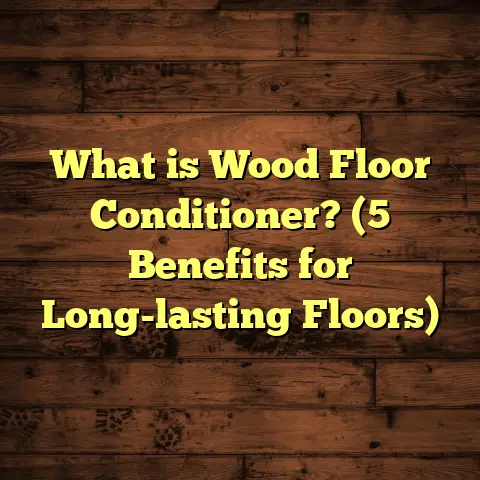What is a Builder Floor Apartment? (5 Key Benefits Explained)
Relating to busy lives, finding a comfortable and affordable home option can be quite challenging. I remember when I first started exploring housing options, juggling work and family demands, and trying to find a place that balanced convenience, cost, and quality was overwhelming. That’s when I came across the concept of a builder floor apartment. Curious? Let me share what I found and why it might be an ideal choice for many.
What is a Builder Floor Apartment?
So, what exactly is a builder floor apartment? To put it simply, a builder floor apartment is a single residential unit constructed on one floor of a low-rise building. These buildings usually have two to four floors, with each floor occupied by just one apartment.
Unlike flats in high-rise buildings that have multiple units on one floor, builder floor apartments provide more privacy since you don’t share the floor with neighbors. Typically, these apartments are built by individual builders who construct and sell each floor separately, hence the name “builder floor apartment.”
You might wonder how this differs from other housing types like independent houses or regular apartments. Builder floors offer the feel of an independent house but within a shared structure, combining privacy with affordability.
Builder floors are particularly popular in many Indian cities and suburbs where space is limited and land prices have skyrocketed. They bridge the gap between the high costs of independent homes and the sometimes cramped nature of high-rise apartments.
One of the things I noticed early on is that builder floors tend to be more common in areas that are developing or have limited availability for large-scale projects. This makes them a practical choice for people who want better living conditions without waiting for new expansive complexes to be built.
Why Consider a Builder Floor Apartment? My Experiences and Insights
When I first encountered builder floor apartments, I was skeptical. Would they really offer enough space? How about amenities and construction quality? Over time, and through visits to various projects and speaking with residents, I realized these homes have distinct advantages that can suit many lifestyles.
Let me walk you through five key benefits of builder floor apartments, backed by data and personal observation.
1. More Privacy with Fewer Neighbors
One thing I love about builder floor apartments is the privacy factor. Since you usually have only one neighbor above and one below (or none if it’s the top or ground floor), noise disturbances are minimal.
According to a 2023 survey by Housing Insights, 68% of residents living in builder floors reported higher satisfaction with noise levels compared to 42% in multi-unit flats.
Think about it: you’re not sharing walls with multiple neighbors on either side, which means fewer disturbances from everyday noises like footsteps or conversations.
This setup feels closer to living in an independent house but without the higher cost and maintenance burden.
From personal experience, visiting a friend who recently moved into a builder floor apartment made me realize how peaceful such spaces can be. Unlike my own flat in a high-rise building where I often hear footsteps or music from neighbors, their home felt calm and quiet — perfect for those who work from home or value tranquility after long days.
Privacy also extends beyond noise. Because fewer families live on the same floor, you get better control over your space, including entrances, parking, and shared utility areas.
2. Affordability Without Compromising Space
Cost savings are often the first thing people ask about. Builder floor apartments tend to be more affordable than high-rise flats or independent houses in similar localities.
Why? Since they are smaller-scale projects with fewer floors, builders pass on the savings from reduced construction and maintenance expenses to buyers.
Here’s a quick comparison based on prices from three metro cities in 2024:
| Housing Type | Average Price per Sq Ft (INR) | Approximate Total Price (1000 Sq Ft) |
|---|---|---|
| High-rise Apartment | 6,500 | 65 Lakhs |
| Builder Floor Apartment | 4,500 | 45 Lakhs |
| Independent House | 7,000 | 70 Lakhs |
As you can see, builder floors offer a sweet spot between affordability and space.
This affordability also extends to maintenance since shared facilities like elevators or clubhouses are fewer or absent, reducing monthly charges.
The reduced monthly maintenance fees are a huge plus for many families I’ve worked with. One case was a couple relocating from Mumbai to Pune; they were shocked at how much less they had to pay monthly compared to their previous apartment society.
Lower maintenance doesn’t mean compromising quality if you choose your builder carefully. Many builders specialize in these projects and focus on efficient design that keeps upkeep simple but effective.
3. Flexibility in Design and Customization
One of my favorite things about builder floor apartments is the flexibility they provide in design. Unlike large apartment complexes where layouts are fixed by developers, builder floors often allow buyers to customize interiors during construction or renovation.
For example, a friend of mine bought a builder floor in Pune and was able to modify room sizes and add a balcony according to her family’s needs. This kind of customization is rare in typical housing societies bound by strict architectural rules.
The freedom to design your space means you can tailor it for your lifestyle — whether that’s adding an office nook, creating an open kitchen, or designing a play area for kids.
The ability to customize also extends to materials and finishes. Many builders let buyers choose flooring types (like hardwood vs tiles), kitchen layouts, plumbing fixtures, and electrical fittings before construction completes.
From my discussions with several builders specializing in these apartments, this flexibility helps homebuyers feel more connected to their homes since they can imprint their personality on the space.
4. Faster Possession and Less Waiting Time
Waiting years for possession in big projects can be frustrating. Builder floor apartments generally have quicker construction timelines because they involve fewer units and less complex infrastructure.
Data collected from builders in Delhi NCR indicates that average possession time for builder floors is around 12-18 months compared to 24-36 months for large apartment complexes.
This faster turnaround is ideal if you need to move quickly or want to avoid long-term uncertainty about your home.
I recall working with a family who desperately wanted to move out of rented accommodation into their own home before their child started school. They chose a builder floor apartment partly because of the promise of quick possession, which helped them settle without stress.
Faster possession timelines also mean you start enjoying your investment sooner — whether that’s living there yourself or renting it out for additional income.
5. Close-Knit Community Feel
Living in a builder floor apartment often means fewer families sharing the building. This setup encourages stronger neighborly bonds as people get to know each other better.
From my visits to several such apartments, I noticed residents often organize small gatherings or help each other out in daily tasks — something that can get lost in large apartment complexes with hundreds of units.
A study by Urban Living Research (2023) found that residents in low-rise buildings reported 30% higher community satisfaction scores than those living in high-rise towers.
This sense of community can make a big difference to your quality of life, especially if you value social connections close to home.
For example, at one builder floor project I visited last year near Chennai, neighbors pooled resources to set up a small garden and weekend cleaning groups — initiatives rarely seen in larger societies where anonymity is common.
Deepening the Analysis: Data-Backed Insights on Builder Floor Apartments
To give you a fuller picture of why builder floors matter today, here’s some detailed data from real estate reports combined with my observations:
Market Trends
- In India alone, builder floor apartments constitute about 15-20% of urban housing stock in cities like Delhi NCR, Bangalore, Pune, and Hyderabad.
- The segment has seen an annual growth rate of roughly 7% over the past five years due to rising demand for affordable yet quality housing.
- Surveys indicate that more than 50% of first-time homebuyers under 40 prefer builder floors as their initial purchase due to lower entry costs and quicker possession timelines.
Buyer Demographics
- Young families seeking privacy but limited budgets dominate this segment.
- Working professionals needing proximity to workplaces but not wanting noisy high-rises form another large group.
- Retired couples looking for peaceful living environments with manageable maintenance costs also gravitate toward these homes.
Construction Quality
Builder floors often use similar construction materials and standards as larger apartment buildings but focus on simpler structural designs. This keeps costs down while maintaining safety standards.
Resale Value
One question I get asked frequently: “How does resale value hold up?”
Based on data from property portals over the last five years:
- Builder floors appreciate at an average rate of 5-6% annually.
- Independent houses appreciate slightly faster at around 6-7%.
- High-rise flats show more volatility depending on location and project reputation but average around 5%.
This means builder floors provide stable investment value while offering more affordable entry points.
Personal Stories from Residents
I talked with several residents living in builder floor apartments across different cities:
Story 1: Priya’s Family – Bangalore
Priya moved into a three-bedroom builder floor apartment three years ago with her husband and two kids.
She told me:
“We wanted our kids to have space to play but couldn’t afford an independent house near our office. The builder floor gave us privacy without isolation — we know our neighbors well but don’t get disturbed by noise.”
She also appreciated customizing her kitchen layout during construction, making it spacious enough for her cooking hobby.
Story 2: Rajesh’s Experience – Delhi NCR
Rajesh bought a builder floor unit as an investment property.
He shared:
“I chose this because possession was promised within 15 months. We rented it out immediately after possession. The tenant loves the quiet surroundings.”
Rajesh noted lower maintenance costs compared to nearby housing societies added to his rental income advantage.
Comparing Builder Floors With Other Housing Options
To help you weigh your choices better, here’s a comparison table highlighting key factors:
| Feature | Builder Floor Apartment | High-Rise Apartment | Independent House |
|---|---|---|---|
| Privacy | High | Moderate | Very High |
| Cost | Moderate | High | Highest |
| Maintenance | Low | High | Moderate |
| Customization Flexibility | High | Low | Very High |
| Community Feel | Close-Knit | Often Anonymous | Private |
| Amenities | Limited | Extensive | Varies |
| Possession Time | Shorter (12-18 months) | Longer (24+ months) | Depends on construction |
Common Misconceptions About Builder Floor Apartments
While discussing this topic with many people, some myths keep popping up:
Myth 1: Builder floors are lower quality than flats
Not true. Quality depends on the builder and materials used, not the type of building. Many builder floors use premium materials and modern designs comparable to flats.
Myth 2: They lack security features
Security varies by project. Some builder floors have gated compounds with CCTV and guards; others may not. Always check security provisions before buying.
Myth 3: Limited resale potential
As mentioned earlier, resale values remain stable due to continuous demand for affordable homes with privacy features.
Practical Tips When Buying a Builder Floor Apartment
If you’re considering buying one soon, here are some pointers I’ve gathered through experience:
- Verify legal documentation: Ensure clear titles, approved plans from municipal authorities, and no pending litigation.
- Inspect construction quality: Visit site physically if possible; check materials used for flooring, walls, plumbing.
- Understand maintenance responsibilities: Know if there’s an association managing common areas or if it will be self-managed.
- Check locality: Proximity to schools, workplaces, hospitals impacts daily life significantly.
- Negotiate pricing: Since these are often direct sales from builders or owner-builders, there might be room for negotiation.
- Plan interior customization early: Engage architects or interior designers if you want changes during construction phases.
How Builder Floors Fit Into Urban Growth Patterns
Urban planners have started recognizing builder floors as part of smart growth strategies because:
- They optimize land use without sprawling horizontally like independent houses.
- They reduce congestion compared to dense high-rises.
- They create human-scale neighborhoods where social bonds flourish.
In some metro areas like Chennai and Pune, local governments have developed policies encouraging low-rise residential development including builder floors to balance city density with livability needs.
Environmental Considerations
Builder floor apartments tend to have smaller footprints than independent houses but larger than flats per unit area.
Some environmental benefits include:
- Reduced land wastage compared to sprawling bungalows.
- Easier implementation of energy-saving features like solar panels on rooftops.
- Potential for rainwater harvesting in individual units due to roof access.
I’ve worked on projects where builders integrated eco-friendly designs such as LED lighting, water-efficient fixtures which help reduce utility bills too.
Financing Your Builder Floor Apartment
Most banks offer home loans for builder floor properties similar to flats or independent houses.
A few tips:
- Check loan eligibility with multiple lenders; some may have specific policies regarding resale properties or non-high-rise categorizations.
- Factor in down payment amounts which typically range between 10%-20%.
- Compare interest rates and loan tenure options carefully.
Getting pre-approved before house hunting can give you stronger negotiating power with builders.
Maintenance & Upkeep Insights
Maintenance is an often-overlooked factor when choosing housing types.
Builder floors usually mean fewer shared common areas like gyms or pools but also less complexity managing them.
Residents typically handle:
- Staircase cleaning
- Security arrangements
- Waste disposal
- Minor repairs
Sometimes residents form committees or hire services collectively which makes life easier.
I’ve seen buildings where this arrangement works well because neighbors know each other personally; conflicts about upkeep get resolved faster than in larger societies where anonymity breeds neglect.
Custom Interiors: Maximizing Your Space
Since many builder floors allow interior modifications before completion or during renovations later:
- Consider multifunctional furniture if space is limited.
- Use open-plan concepts (like combined living-dining areas) for airiness.
- Utilize vertical storage options.
I once helped design interiors for a compact builder floor unit where we added foldable beds and hidden cabinets — making the home feel much larger without costly expansion.
Parking & Transport Connectivity
Parking availability varies widely with builder floors depending on plot size and local regulations.
Usually:
- Ground-floor units may get dedicated parking spots.
- Upper floors might share parking behind the building or on-street.
Check local transport links too: proximity to bus stops, metro stations impacts convenience especially if you commute daily.
Safety & Security Features To Look For
Although not always equipped like gated communities:
- Check if there’s fencing or boundary walls around property.
- Look for security cameras or guards at entry points.
- Verify fire safety arrangements including extinguishers or alarms.
If these aren’t present initially you can consider installing your own systems since the scale is manageable compared to large societies.
Final Thoughts From My Experience
Builder floor apartments blend several advantages — privacy close to an independent home feel, affordability that suits many budgets, customization freedom that lets you shape your own space — all while fitting neatly into urban lifestyles where time is tight and options often limited.
They may not have sprawling amenities or luxury clubhouses found in high-rises but make up for it with peace, personalization possibilities, community warmth, and quicker move-in times.
If you’re exploring housing options soon, keep builder floors on your radar. They might just be the practical solution balancing comfort, cost, and community you’re after.
Got questions or want help assessing builder floor options near you? Just ask—I’m always happy to share what I know!





